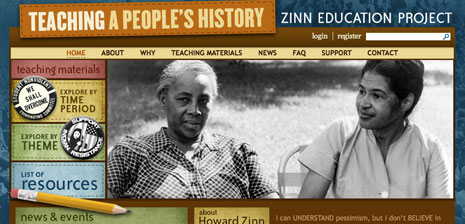BROWSE BY CATEGORY
- Archives and Libraries
- Blogs and Networking
- Bookmark This
- Digital Tools
- Examples of Teaching
- Exhibits
- Film Reviews
- History and Headlines
- Historic Sites and Museums
- Historical Thinking
- Holidays and Heritage
- Issues and Research
- Lesson Plans
- Material and Visual Culture
- Multimedia
- Organizations and Agencies
- Primary Sources
- Professional Development
- Publications
- Student Activities
- Teaching Materials
- Websites
The People Speak: To Zinn or Not to Zinn

Howard Zinn is perhaps not a historian's historian. Scholarly judgments of his publications frequently challenge his factual foundation as well as the tunnel vision of his ideology.
Zinn is, however, a people's historian, and artists such as Matt Damon, Josh Brolin, Morgan Freeman, Viggo Mortensen, and Rosario Dawson spotlighted Zinn's emphasis on social change and the power of protest throughout American history with the documentary The People Speak on The History Channel on December 13, 2009.
Two-minute vignettes of celebrities performing letters, diaries, and speeches of everyday Americans from the program are available at the History Channel. They include actor Michael O'Malley reading the words of a Revolutionary War general, Matt Damon reading and discussing the Declaration of Independence, Jasmine Guy reading the commencement address of Marian Wright Edelman, and Christina Kirk reading Susan B. Anthony's statement at her suffrage trial.
A DVD of the program is scheduled for release shortly, and Amazon is one source for the soundtrack and other Zinn audiovisuals.
Additional video appears at Voices of a People's History, informal readings of more primary source materials from people categorized as rebels, dissenters, and visionaries from our past—and present—with Howard Zinn's comments.
Chapter-by-Chapter free PDFs of A People's History are offered through History is a Weapon website.
Zinn's opus, A People's History of the United States, 1492-Present, has gone through five editions, multiple printings, sold more than two million copies, and has been assigned in thousands of high school and college history classes since first published in 1980. Zinn is quite clear about the bias of the book: "With all its limitations, it is a history disrespectful of governments and respectful of people's movements of resistance."
Even historians who don't agree with Zinn's historical perspective acknowledge him as the most influential historian in America. But Daniel Flynn, executive director of Accuracy in Academia says Zinn puts theory first and facts second because he simplistically divides "mankind into two groups—and only two: oppressors and oppressed." Public historian Larry Dewitt decries the lack of balance in Zinn's work, "...we study history to find out what happened in the past and why. For Zinn, and like-minded historians, the discipline of history is merely a tool to be used in the pursuit of political cause."
The eminent Eric Foner wrote in his 1980 New York Times review of A People's History, "The book bears the same relation to traditional texts as a photographic negative does to a print: the areas of darkness and light have been reversed."
Howard Zinn excites history students. He involves them. He provokes discussion, controversy, argument. He encourages them to think about whether and how they have the ability to create direction and change.
Like any material, the effectiveness of teaching with A People's History (or any Zinn publication) depends on how the information is taught. Eric Foner continued in his review to state, "At issue here is not simply a question of 'balance' or of comprehensive coverage; every work of history is selective. What is needed, however, is an integrated account incorporating both Thomas Jefferson and his slaves, Andrew Jackson and the Indians...in a continuing historical process, in which each group's experience is shaped in large measure by its relation to others."
If lessons are rooted in promoting critical thinking skills, examination of multiple perspectives, and cross-checking and evaluating facts, Zinn's narrative offers rich opportunities for point-and-counterpoint discussion, projects, and papers encouraging students to challenge evidence of primary and secondary sources and to draw conclusions.
Teaching a People's History from the Zinn Educational Project offers lesson plans and teaching materials by theme and time period. The site also provides a thorough explanation of Howard Zinn's ideas for Teaching for Change.
And if you'd like to ask Zinn himself a question about his life and his ideas, submit them via email to zep@zinnedproject.org by FRIDAY, JANUARY 8, 2010, for consideration for an "Ask Howard" hour radio broadcast of Authors on Air.